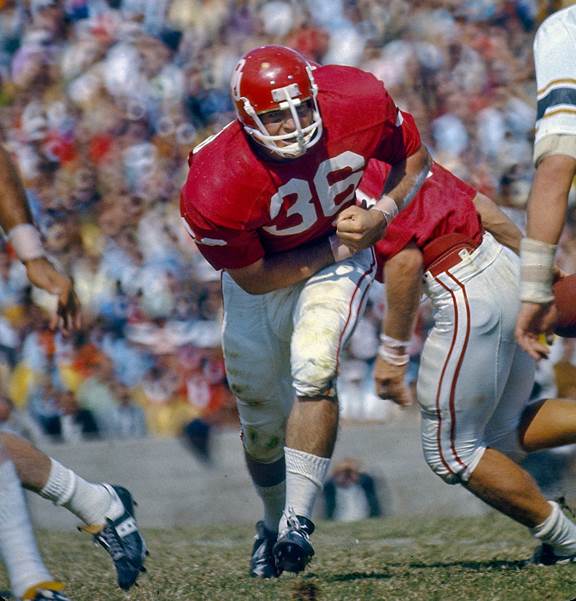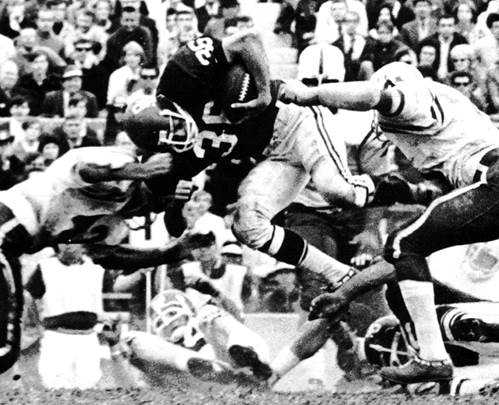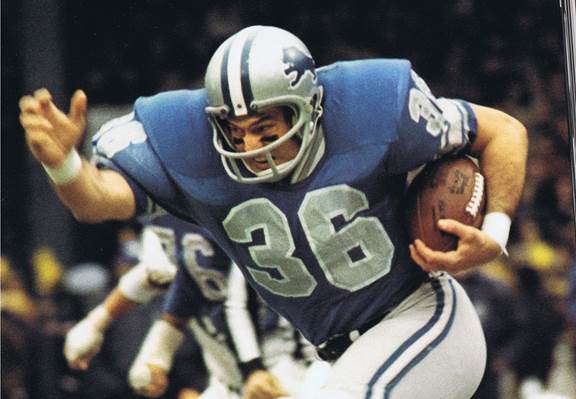

"STEVE OWENS, AN UNDERRATED HEISMAN WINNER"
HELMET HUT NEWS/REFLECTIONS May 2017:
"STEVE OWENS, AN UNDERRATED
HEISMAN WINNER"
By Dr. Ken
In 1969 the
winner of the
Heisman Trophy
was determined
by the votes of
1,371 football
writers and
broadcasters as
well as past
Heisman winners.
The award had
already become
little more than
a “Best
Quarterback Or
Running Back Of
The Year From A
Prestigious
Conference”
Trophy but this
was the tail end
of voters giving
some
consideration to
those from a
broader range of
conferences than
they do today,
as well as the
occasional
defensive
performer. 1969
offered up a
great group of
potential
winners
including Steve
Owens of
Oklahoma, Archie
Manning of
Mississippi,
Mike Phipps of
Purdue, Rex
Kern, Jim Otis,
and Jack Tatum
of Ohio state,
Lynn Dickey of
Kansas State,
Dennis Dummit of
UCLA, Jim
Plunkett of
Stanford, and
defensive
players Mike
McCoy of Notre
Dame and Mike
Reid of Penn
State as well as
Tatum. All had
supporters and
all had reasons
for supporting
the vote or
negating it. In
Owens’ case, the
Sooners’ 6 - 4
record was a
black mark in
voters’ minds as
was the
lackluster 7 – 4
mark of the 1968
season. However,
in a time when
only in-season
games counted in
the statistical
compilation,
Owens had a
three season run
of All
Conference
nominations and
Big Eight
rushing leader
honors, and
those regular
season rushing
totals of 808,
1536, and 1523
yards. The
distinction of
gaining over 150
yards per game
consistently for
two years was
highlighted by
the fact that he
rushed the
football 357
times in 1968
and 358 in ’69.
Except for O.J.
Simpson’s 355
carries in his
Heisman winning
season of ’68,
no one else was
close. Owens
took a beating,
primarily
running inside
against Texas,
Colorado, and
Kansas State,
all tough-guy
squads during
those seasons.
He had surpassed
the conference
rushing totals
but his career
rushing yards
total and
touchdowns per
game average
were NCAA
records and his
seventeen
consecutive
100-yard games
was something
that no one
before had
approached when
rushing for 100
yards in any
game truly had
meaning. Three
of his senior
outings resulted
in 200-plus yard
accomplishments.
Owens did win
the Heisman,
certainly for
being a
Consensus All
American, his
gaudy
statistics, and
excellent
leadership and
team oriented
attitude. In
fact he was so
revered by his
teammates that
they issued a
statement prior
to his ’69
senior season
that “Steve
deserves the
Heisman” and the
squad was
dedicated to
helping him earn
it. Minus
today’s
media-driven
hoopla and
immediate
internet
notification,
the Heisman
Trophy remained
a singular honor
but one that was
most appreciated
by those with a
more intimate
relationship to
it. For Owens,
it was a
justification of
his teammates’
play despite a
disappointing
record, and less
of his
individual
ability or
accomplishments.
Loren Everett
“Steve” Owens,
born in Gore and
having grown up
in Miami,
Oklahoma, had
already exceeded
his goal of
“being good
enough to play
for the Miami
High Wardogs.”
Perhaps typical
of rural
youngsters in a
long-ago era, he
became attached
to the powerful
OU Sooners while
listening to
their games on
the radio. As a
three year high
school starter,
he filled the
fullback and
linebacker
positions well,
dreamed about
playing in
Norman, and
college
recruiters began
their contact
his junior year.
Playing
basketball and
being the state
champion in the
high hurdles,
high jump, and
broad jump gave
indication of
his athletic
ability and he
was indeed “good
enough” as a
Miami Wardog,
sharing the
“Oklahoma Back
Of The Year”
designation with
Rick Baldridge
of Lawton who
became his
back-up with the
Sooners. Always
visualizing
himself as a
Sooner, Steve
also built a
strong
relationship
with Arkansas
assistant Jim
MacKenzie. With
OU struggling
through a 3 – 7
year and
MacKenzie
present to
welcome him with
open arms to Hog
Nation, Owens
was torn until
Oklahoma head
coach Gomer
Jones was
relieved of his
duties and
MacKenzie was
named the new
Sooners head
man. The new
head coach went
to Steve and
said, “…follow
your dreams of
becoming a
Sooner” and he
did although he
missed his small
hometown enough
to consider
leaving during
his freshman
year to attend
junior college.
The sudden death
of Coach
MacKenzie also
brought a cloud
that hung over
the program.
With six
siblings at
home, his father
made it clear he
would have to
remain at OU if
only because “we
don’t have any
room here.” Of
course, his
homesickness was
overcome and his
career was off
to a hot
beginning as in
his second
varsity game at
OU, he ran for
129 yards
against
Maryland,
kick-starting a
surprising 10-1
mark in 1967
under new coach
Chuck Fairbanks,
with the only
loss a 9 – 7
squeaker to
rival Texas on
the season’s
third weekend.
Owens marked
himself as a
potential
stand-out and in
fact was,
despite the step
back the team
took in his
junior and
senior seasons.
The team had
dedicated its
1967 season to
the memory of
Coach MacKenzie
and there was an
emotional
letdown going
into ’68. It was
Steve’s
consistency that
made him such a
valuable player
and no one is
going to argue
the point that
seventeen
consecutive
100-plus yard
games that
spanned his
entire senior
season did not
demonstrate
consistency.
Interestingly,
the Heisman
voting was
completed and
announced prior
to OU’s final
game of the
season against
Oklahoma State.
Despite being
the underdog,
Steve’s
collegiate
finale
performance of
261 yards on a
NCAA record
fifty-five
carries would be
the best of his
entire career
and lead his
squad to a 28 –
27 upset
victory. Rushing
for two
touchdowns also
sealed his
position as the
nation’s leading
scorer as well
as leading
rusher. Owens
made the
statement,
“"That was the
greatest
individual game
I've played, the
Heisman Trophy
stuff was over
and I didn't
have to worry
about it. I
tried to play
like a Heisman
Trophy winner
and I think I
did." He also
won the Walter
Camp Player of
the Year Award
and completed
his collegiate
career as the
holder of seven
NCAA rushing
records and nine
Big Eight
Conference
marks.
Owens always
gave credit to
his blocking,
especially that
of fullback Mike
Harper, a 5’11”,
190 - pounder,
and as much as
anything else,
that defined who
Owens was, truly
a “team first”
individual. He
had tremendous
respect for the
OU staff that
included Galen
Hall, Barry
Switzer, Larry
Lacewell, and
Pat James and
prior to the
1969 finale
against Oklahoma
State, the word
was circulating
that this could
in fact be the
finale for
Fairbanks and
his staff also.
Owens took it
upon himself to
bring the
captains
together and
stated, “Look,
these coaches
are great
coaches, we got
to go win this
game for them.”
He saw the
future potential
of both the
staff and the
recent
recruiting
class, knew that
the darker days
of the Gomer
Jones years and
the death of Jim
MacKenzie were
behind the team,
and wanted his
school to move
forward without
interruption.
The OSU team, in
addition to
being a rare
favorite over
its in-state
rival, had
talent with an
NFL first round
draft choice in
tackle John Ward
and Cleveland’s
second round
pick Jerry Sherk.
Without a bowl
game to look
forward to, this
Bedlam Series
game, especially
on the
infrequent
occasion of a
Cowboys victory
prediction,
marked a special
occasion and for
Owens, his swan
song. He and his
teammates made
it count,
leaving a great
“last
impression” for
pro scouts prior
to the 1970
draft.
Thus, we have
Steve Owens,
clean-cut, a
family man
married to his
high school
sweetheart,
highly respected
for his team
oriented and
selfless play.
He was never in
trouble and
served as a
reflection of
the solid values
instilled in him
by what was at
the time, his
rural Oklahoma
upbringing. In
fact his dad was
driving a truck
through Dallas
on the day the
Heisman award
was announced
and pulled into
a truck stop to
call home and
ask his wife,
“Did the boy win
that there
trophy?” The
“personal stuff”
was not the
emphasis. The
Veer and
Wishbone had
been introduced
and were taking
off as the
dominant
offenses in
college football
thus a
hard-nosed,
run-the-ball-inside
tough guy back
like Owens was
on the cutting
edge of being an
offensive
engine’s
important
component after
a competent
run-and-pitch
quarterback. Why
then, is he not
one of the most
memorable
Heisman Trophy
honorees in the
minds of fans
and historians?
My
“partner-in-crime”
during my
elementary
school years was
Richard
Landsman. Like
me, a solid
athlete and
student, he was
also a football
nerd, a kinship
that has kept
our relationship
going to this
day six decades
later. Although
we were perhaps
too young to
appreciate the
exploits of
Billy Vessels,
Alan Ameche, and
Paul Hornung, we
certainly knew
who they were
and what they
had
accomplished. By
the time John
David Crow won
the 1957 Heisman
Trophy, we were
full-fledged
college football
fans and we were
ecstatic when
our very
favorite player,
Pete Dawkins was
named the winner
for 1958 [ see
HELMET HUT
Unfortunately,
fans often
equate a Heisman
Trophy holder’s
professional
career with
their college
exploits, with
one somehow
justifying the
other. Owens has
a well-earned
place in the
College Football
Hall Of Fame and
how would he
not? His
professional
career which
began as the
nineteenth
player taken in
the NFL Draft by
the Lions also
began with a
pre-season
shoulder injury,
limiting his
participation to
but six games
and thirty-six
carries. He
roared back to
expected
greatness in
’71, rolling up
1045 yards and
putting in 246
carries. He
became a Pro
Bowl player and
the first
Detroit Lion to
gain 1000
rushing yards in
a season.
Despite being in
a backfield
crowded with
excellent
talent, Owens
was a cog but
had a decreasing
number of
carries despite
“always coming
to play” as his
coaches put it,
and suffered the
effects of
injury. The
final blow
occurred without
a blow being
delivered on
Thanksgiving Day
in 1974. Owens
leaped over a
fallen Packers
opponent, hit
the slick turf
and went down
with a
devastating left
knee injury. The
damage cost him
the entire 1975
season in
rehabilitation
and despite some
reports that he
would attempt a
comeback in ’76,
the reports
going into the
Lions camp
stated that
“Owens must be
considered
questionable
until he
survives the
tests of the
preseason. As a
precaution, the
Lions used their
second No. 1
draft choice for
Lawrence Gaines,
a power
fullback.” That
precaution
proved necessary
as Owens
announced his
retirement,
unable to
perform up to
his standards.
He completed his
pro career with
2,451 yards and
twenty rushing
touchdowns while
adding another
861 receiving
yards with two
touchdowns.
Perhaps the
disappointment
of his
professional
career in some
way tarnished
his memory as a
pile driving and
pile moving
force that set
NCAA records.
Certainly “those
who count”
remembered as
Steve was voted
into the College
Football Hall Of
Fame, the
Oklahoma Sports
Hall Of Fame,
the Orange Bowl
Hall Of Honor,
and was named
the Walter Camp
Foundation
Alumnus Of The
Year. He proved
to be a
successful
business
executive and
returned to
Norman to serve
as Oklahoma’s
Athletic
Director from
1996 to 1998, a
position he left
for the sake of
his family after
the passing of
his son. He has
devoted a
tremendous
amount of time
to various
national and
local charitable
endeavors. A
statue of Steve
Owens stands
outside of OU’s
Memorial Stadium
where he remains
a revered figure
but for those
nationally, he
is one of the
Heisman winners
most deserving
of praise, yet
one that is
often neglected.



